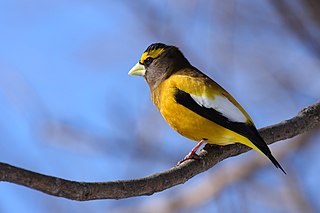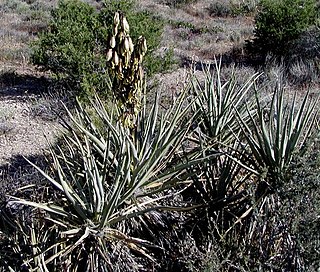
The evening grosbeak is a passerine bird in the finch family Fringillidae found in North America.

Yucca baccata is a common species of yucca native to the deserts of the southwestern United States and northwestern Mexico, from southeastern California north to Utah, east to western Texas and south to Sonora and Chihuahua. It is also reported in the wild in Colombia.

Cryptophagidae is a family of beetles with representatives found in all biogeographic realms. Members of this family are commonly called silken fungus beetles and both adults and larvae appear to feed exclusively on fungi although in a wide variety of habitats and situations, such as rotting wood and shed animal fur and feathers. These beetles vary from about 1 to 11 millimeters long, and usually have an oval body shape with a slight "waist".

Ransoniella punctata, common name the brown-spotted cowry, is a species of sea snail, a cowry, a marine gastropod mollusk in the family Cypraeidae, the cowries.

Eucalyptus mannensis, commonly known as Mann Range mallee, is a species of mallee that is native to Western Australia, South Australian and the Northern Territory. It has rough bark at the base of the trunk, smooth bark above, narrow lance-shaped adult leaves, flower buds in groups of between seven and eleven, creamy white flowers and hemispherical fruit.
Leptophlebia vespertina is a species of pronggill mayfly in the family Leptophlebiidae. It is found in Europe.
Atomaria wollastoni is a species of silken fungus beetle in the family Cryptophagidae. It is found in Europe and Northern Asia and North America.

Atomaria is a genus of silken fungus beetles in the family Cryptophagidae. There are more than 160 described species in Atomaria.
Atomaria stricticollis is a species of silken fungus beetle in the family Cryptophagidae. It is found in North America.
Atomaria ephippiata is a species of silken fungus beetle in the family Cryptophagidae. It is found in North America.
Atomaria nigrirostris is a species of silken fungus beetle in the family Cryptophagidae. It is found in Africa, Europe and Northern Asia, and North America.
Atomaria lederi is a species of silken fungus beetle in the family Cryptophagidae. It is found in Europe and Northern Asia, North America, and Southern Asia.
Serica vespertina is a species of scarab beetle in the family Scarabaeidae. It is found in North America.
Atomaria fuscata is a species of silken fungus beetle in the family Cryptophagidae. It is found in Europe and Northern Asia, North America, and Southern Asia.
Hypena atomaria, the speckled snout moth, is a species of moth in the family Erebidae.
Atomaria testacea is a species of silken fungus beetle in the family Cryptophagidae. It is found in Africa, Europe and Northern Asia, and North America.
Atomaria apicalis is a species of silken fungus beetle in the family Cryptophagidae. It is found in Europe and Northern Asia and North America.
Atomaria distincta is a species of silken fungus beetle in the family Cryptophagidae. It is found in North America.
Senna atomaria, the flor de San Jose, is a species of flowering plant in the family Fabaceae, native to Mexico, Central America, the Caribbean, Colombia, and Venezuela. A shrub or small tree, it is considered a multi-purpose species; fuel, wood, biomass, soil improvement, medicine, and ornament.





